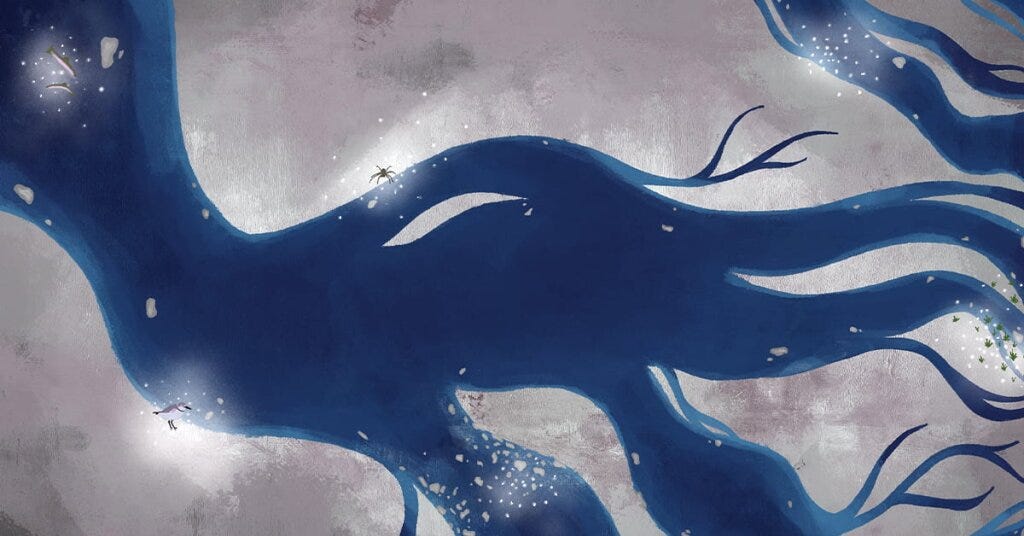Emergence: How interactions create complexity from simplicity
Emergence is about how complex patterns, structures, and behaviours arise from interactions – giving rise to new system properties
This post was originally published on the Te Pūnaha Matatini website. Te Pūnaha Matatini is a New Zealand Centre of Research Excellence in Complex Systems where I am a Principal Investigator.
I co-wrote this with my collaborator Julia Talbot-Jones along with Jonathan Burgess, Te Pūnaha Matatini’s Communications and Marketing Senior Adviser (and ace musician). The wonderful artwork was done by Hanna Breurkes.
Julia and I have recently been funded by Te Pūnaha Matatini for a very exciting project on “Tackling the complex climate-biodiversity challenge using transdisciplinary thinking”. I’m sure many of you will be interested in this project so I’ll keep you posted as it evolves. The beauty of research centres like Te Pūnaha Matatini is that they allow more risky, creative approaches to research that offer great potential, but could be challenging to fund through traditional means.
But why study complex systems? Go check out the rest of the Foundations of complex systems series written by other Te Pūnaha Matatini researchers.
“This is the second of a series of posts on complexity. We’ll be exploring some of the ways that studying complex systems gives us a more nuanced way of understanding the world, how this is relevant to all our lives, and the unique contributions we can make to this new way of understanding the world from Aotearoa New Zealand.”
If you’re new here, this is a deviation from my normal content, but hopefully you learn something new and get a sense of what we do at Te Pūnaha Matatini. Let’s dig into the post…
The Makarora River sparkles in a distinctive blue as it winds its way from the Southern Alps into Lake Wānaka. When it reaches Boiler Flat, it splits into shallow channels that flow around ever-shifting small islands in its gravel bed. This river is a braided river — an iconic feature of Te Waiponamu, the South Island of Aotearoa New Zealand.
It’s hard to imagine much life thriving among the floods, droughts, instability and tonnes of gravel that characterise braided rivers. But if we zoom out to consider their entire breadth, braided rivers support an immense diversity of life.
Braided rivers are complex systems made up of interweaving channels that change continuously as water flow shifts and deposits sediments. This creates a changing mosaic of habitats from pools, to fast-flowing channels, to islands, that are the result of interactions between flow, sediment, and organisms like plants.
The groups of species found in different parts of a braided river are constantly changing. Depending on environmental conditions and how recently it was ripped apart by a flood, a patch could be empty or comprise any combination of species. Within each of these patches, the species interact with each other in the form of competition for resources or predation.
A complex, tangled web of life holds things together across braided rivers.
What is emergence?
Surprisingly, when all these local patches of a braided river are considered together, the composition and diversity of species in the overall system tends to stabilise through time.
This stability is explained by ‘emergence’ — a key concept in complex systems. Emergence is a process we see everywhere, and occurs when small things interact to create larger things which also interact, behaving in new and unexpected ways.
The stability of whole braided rivers results from the complex interplay between physical and biological processes, feedbacks between different elements and systems, and their ability to self-organise. That is, the stability of the whole river system emerges from its unstable component parts.
Where else can we see emergence?
Complex systems cannot be described by simply adding together their parts. Instead, a higher property is made possible by the interactions or relationships operating within, and between, their parts.
Perhaps the poster child for all this is consciousness. This phenomenon has baffled scientists for centuries. Where does consciousness come from? How does it work? Although consciousness remains unexplained in many ways, scientists know that it emerges from complex interactions among a wide range of parts and processes in the brain.
We now know what the brain comprises, and how neurons — of which there are around 86 billion — work by sending electrical and chemical signals to each other. But consciousness itself remains unexplained, emerging from the interaction of neurons and the collective activity of this network in the brain. Like the whole braided river, consciousness cannot be reduced to any single neuron or neural circuit.
Emergence occurs in the social world as well. Every day, over eight billion people wake up, and go about the mundane tasks that take up most of our human lives. We get dressed, we eat, we imagine, we create, and we do what we can to survive. But our individual behaviour does not necessarily predict how societies function, because of the diverse connections and resulting complex feedbacks among humans.
We can see this in market economies where companies, civil society and governments interact. Prices and trends arise from the interaction of many buyers and sellers and government rules. These interactions can lead to outcomes and outputs not necessarily anticipated from a single exchange.
Although these interactions can have positive outcomes, such as efficient resource allocation, innovation, and overall economic welfare, they can also be undesirable. The 2007-08 Global Financial Crisis provides an example of this. In this case, emergent behaviours within financial markets, driven by complex interactions and systemic risks, led to substantial global economic and financial disruption that was largely unanticipated.
Emergence is one of the key processes that explains how our world works
Emergence is about how complex patterns, structures, and behaviours arise from interactions — giving rise to new system properties not found in the individual components alone.
Go check out the rest of the Foundations of complex systems series. The next post in this series takes a look at how systems self-organise, adapt and evolve over time through a process known as feedback.











This is so interesting! I especially love the consciousness example of emergence. In yogic philosophy, we think of consciousness or awareness as a result of how we move through the world. When I read your post, it sort of gave me a new language for that. I'm really keen to learn more about emergence. Thank you for sharing. 🙂
The concept of emergence sounds really intriguing.
We could use some more stability around here ; )
A few years ago, I read some news stories about a new "law of increasing complexity" being proposed by some scientists that would explain increasing complexity in both living and nonliving phenomena, such as evolution, but also the periodic table growing bigger over time with larger elements. Haven't seen much on it since, but I'm fascinated by the topic.